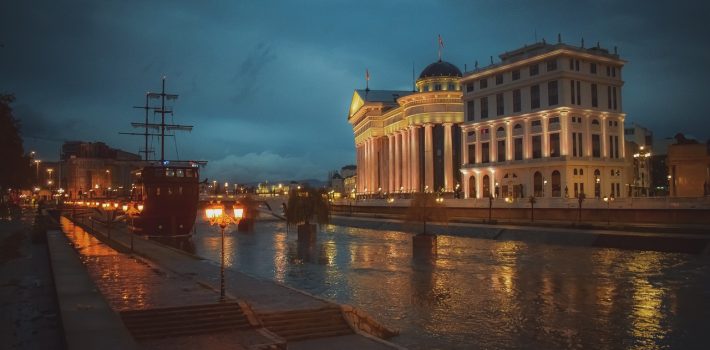Skopje – North Macedonia
Skopje is the administrative center and capital of the Republic of North Macedonia. It is the former capital of the Socialist Republic of Macedonia. It was one of the six federal units of the Socialist Federal Republic of Yugoslavia. The Republic of Macedonia, after the dissolution of the SFRY in 1991, became an independent state and Skopje became its capital. It is located in the heart of the Balkan peninsula, on the Vardar River. It is the political and cultural center of this country, which has a little over two million inhabitants. Skopje alone has about half a million inhabitants.
A very large number of people travel from Belgrade to Skopje
Archaeological data indicate that people inhabited this area around 4,000 years before Christ. Skopje was a regional center both during the Roman rule and during the time under the Eastern Roman Empire, Byzantium, Bulgaria, Serbia, the Ottoman Empire and now, North Macedonia. The city is located at 238 meters above sea level, which is why there are outer parts of the city that reach up to 400 meters above sea level. The city was named after the Skopje basin, in which the city itself is located. The basin is surrounded by the mountains Vodno and Skopska Crna gora.
The main feature of this beautiful city is the stone bridge that, according to some data, was built by the Serbian Emperor Dušan, who was crowned Emperor of the Serbs and Greeks in this city in 1346. This bridge connects the new and the old part of the city, i.e. divides it, as the city’s residents themselves say, into Macedonian and Albanian parts. The coronation took place at Kale fortress, also one of the most important landmarks of Skopje. It, like most important buildings in Skopje, was significantly damaged by the strong earthquake that hit Skopje in 1963.
History
Probably as a consequence of this destruction and partial search for its identity, Skopje these days resembles a synthesis of Rome and Athens, Paris and Washington. It is full of monuments that are maybe ten years old at the most and made in the style of 1,000 years ago or more. The only thing missing is an obelisk to make the impression completely confusing. It is your choice whether to go to the Holocaust museum, which was created in this city for, I believe, unknown reasons even to historians. Or to the National Theater, the Museum of the Macedonian Struggle for Independence and above the underground parking lot, it depends only on your desire and determination to start the tourist tour from there.
It is enough just to cross the street, there is the Kale fortress where the history of this picturesque area is written to some extent. The concentration of historical and all kinds of other monuments in this city is incredible. If the history goes back twenty years. Thus, we can only count what can be seen and what can be photographed for a memory and a long memory.
Landmarks
• The house where Mother Teresa was born, then
• Porta Makedonija – a triumphal gate in the southern Balkan style leading to Makedonija Square with an imposing monument to Alexander the Great that dominates this space.
• There are Macedonian opera, philharmonic, and ballet. The bridge of art with the statues of Macedonian artists lined up, as well as the bridge of civilization. Then the Women’s Park, the Mother’s Fountain. The number of lion statues is impressive.
Monuments
• There is also a monument to Justinian, Philip of Macedon, the bull of Wall Street. Strange that they dropped the wild boar one from Florence. You can also visit two stone ships that seem to levitate above the surface of the river. Purpose – unknown, restaurants in the attempt. The old part of the city, if nothing else, has at least remained its own, probably the way it was 70-80 years ago, maybe even more. Lots of authentic facades, shops. The most famous religious buildings in Skopje are
• Mustaf Pasha Mosque, which was built in the 15th century and
• Cathedral Church of the Macedonian Orthodox Church. The Church of the Holy Savior, built by Emperor Dušan, contains the sarcophagus of Gota Delchev – a revolutionary whom Bulgarians consider Bulgarian and Macedonians – normally, Macedonian.
Taverns
Maybe the North Macedonians are searching for their identity, so to some extent this overemphasized cramming of memory and where it should and where it shouldn’t is justified to some extent, but as far as song, dance and gastronomy are concerned, they definitely don’t have to. As in the greater part of southern Serbia, as well as in all of North Macedonia, and in Skopje itself, you can hardly enter a restaurant without being hungry. More precisely, it is simply impossible to remain indifferent. Pastrami, pinđur, kevapi, ajvari, tavče na gravče, who knows how many varieties of dishes with cabbage, beans, peppers… We should not forget the Macedonian bieno cheese – very high quality sheep’s cheese.
• The main aperitif is Žolta (yellow grape brandy). Macedonians can absolutely boast of the high quality of wines made from indigenous grape varieties and European varieties. Although, Macedonians simply divide it into red and white wine – Vranec and Smederevka. Please. Some of the cafes-restaurants that you must visit:
• Skopje Merak,
• Inn Dukat,
• Kai Serdarot,
• Stari Grad beer hall,
• Two Elenas,
• Macedonian hook,
• Old City house etc etc ..
Nightlife
Skopje, as the capital, also abounds in rich cultural events. Whether you want to go to a quality rock gig or concert, turbo folk trash or a disco in search of good electronic sound, you won’t have any problems. There is something for everyone. Club Epicenter, Sector 909, Intermezzo, Night club Saloon, Garson, Vox, Avenue, XL and so on.
All in all, the city of Skopje – something for everyone, nothing for anyone. The smart ones will find entertainment and pleasure, the others will write blogs and whine.














